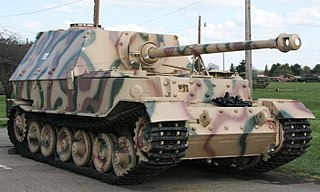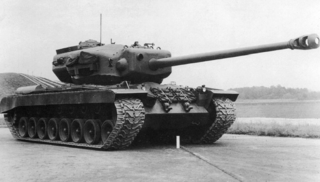
The M4 Sherman, officially Medium Tank, M4, was the most widely used medium tank by the United States and Western Allies in World War II. The M4 Sherman proved to be reliable, relatively cheap to produce, and available in great numbers. It was also the basis of several successful tank destroyers, such as the M10, Achilles and M36. Tens of thousands were distributed through the Lend-Lease program to the British Commonwealth and Soviet Union. The tank was named by the British for the American Civil War general William Tecumseh Sherman.

The T-34 is a Soviet medium tank introduced in 1940, famously deployed during World War II against Operation Barbarossa.

The Tiger II is a German heavy tank of the Second World War. The final official German designation was Panzerkampfwagen Tiger Ausf. B, often shortened to Tiger B. The ordnance inventory designation was Sd.Kfz. 182. It is also known under the informal name Königstiger, often translated literally as Royal Tiger, or somewhat incorrectly as King Tiger by Allied soldiers.

The Kliment Voroshilov (KV) tanks is a series of Soviet heavy tanks named after the Soviet defence commissar and politician Kliment Voroshilov which operated with the Red Army during World War II. The KV tanks were known for their heavy armour protection during the early stages of the war, especially during the first year of the German invasion of the Soviet Union. In certain situations, even a single KV-1 or KV-2 supported by infantry could halt large German formations. The German Wehrmacht at that time rarely deployed its tanks against KVs, as their own armament was too poor to deal with the "Russischer Koloss" – "Russian Colossus".

The T-35 was a Soviet multi-turreted heavy tank of the interwar period and early Second World War that saw limited production and service with the Red Army. Often called a land battleship, it was the only five-turreted heavy tank in the world to reach production, but proved to be slow and mechanically unreliable. Most of the T-35 tanks still operational at the time of Operation Barbarossa were lost due to mechanical failure rather than enemy action.

The BT tanks were a series of Soviet light tanks produced in large numbers between 1932 and 1941. They were lightly armoured, but reasonably well-armed for their time, and had the best mobility of all contemporary tanks. The BT tanks were known by the nickname Betka from the acronym, or its diminutive Betushka. The successor of the BT tanks was the famous T-34 medium tank, introduced in 1940, which would replace all of the Soviet fast tanks, infantry tanks, and medium tanks in service.

The Panzer I was a light tank produced in Nazi Germany in the 1930s. The name is short for the German Panzerkampfwagen I, abbreviated PzKpfw I. The tank's official German ordnance inventory designation was Sd.Kfz. 101.

The Panzer II is the common name used for a family of German tanks used in World War II. The official German designation was Panzerkampfwagen II.

The Panther is a German medium tank deployed during World War II on the Eastern and Western Fronts in Europe from mid-1943 to the war's end in 1945. It had the ordnance inventory designation of Sd.Kfz. 171. It was designated as the Panzerkampfwagen V Panther until 27 February 1944, when Hitler ordered that the Roman numeral "V" be deleted. Contemporary English language reports sometimes refer to it as the "Mark V".

The Jagdtiger is a German casemate-type heavy tank destroyer from World War II. It was built upon the slightly lengthened chassis of a Tiger II. Its ordnance inventory designation was Sd.Kfz. 186. The 71-tonne Jagdtiger was the heaviest armored fighting vehicle (AFV) used operationally by any participant nation of WWII and is the heaviest combat vehicle of any type to achieve series production during the conflict. The vehicle was armed with a 128 mm PaK 44 L/55 main gun which was capable of outranging and defeating any tank or AFV fielded by the Allied forces. It saw brief service in small numbers from late 1944 up until the end of the war on both the Western and Eastern Front. Although 150 were ordered, only between 70 and 88 were produced. Due to an excessive weight and a significantly underpowered drivetrain system, the Jagdtiger was continuously plagued with various mobility and mechanical problems. At present, three Jagdtigers survive in different museums around the world.

The Elefant was a heavy Jagdpanzer used by German Wehrmacht Panzerjäger during World War II. Ninety-one units were built in 1943 under the name Ferdinand, after its designer Ferdinand Porsche, using tank hulls produced for the Tiger I tank design abandoned in favour of a Henschel design.

Nazi Germany developed numerous tank designs used in World War II. In addition to domestic designs, Germany also used various captured and foreign-built tanks.
R3, R.III or R-3 or R/3 may refer to:

The Carro Armato M15/42 was the last Italian medium tank produced during World War II. It was based on the earlier M13/40 and M14/41 medium tanks, and was built with the lessons from the North African Campaign in mind. The tank was meant to be a stopgap until the heavier P26/40 tank could be produced in numbers. It did not serve in North Africa, the theatre in which it was intended to operate, but served in Italy and in Yugoslavia with the German Wehrmacht.

The ZiS-2 was a Soviet 57-mm anti-tank gun used during World War II. The ZiS-4 was a version of the gun meant to be installed in tanks. ZiS stands for Zavod imeni Stalina, the official title of Artillery Factory No. 92, which produced the gun first.

The Heavy Tank T29 and Heavy Tank T34 were American heavy tanks projects started in March 1944 to counter the appearance of the German Tiger II heavy tank. The T26E3 medium tank, weighed around 45 short tons, but was not considered heavily enough armed or armored to counter the Tiger II, which weighed closer to 69 t. The T29 was not ready in time for the war in Europe, but it did provide post-war engineers with opportunities for applying engineering concepts to artillery and automotive components.

The Tiger I, a German heavy tank of World War II, operated from 1942 in Africa and Europe, usually in independent heavy tank battalions. It was designated Panzerkampfwagen VI Ausf H during development but was changed to Panzerkampfwagen VI Ausf E during production. The Tiger I gave the German Army its first armoured fighting vehicle that mounted the 8.8 cm KwK 36 gun. 1,347 were built between August 1942 and August 1944. After August 1944, production of the Tiger I was phased out in favour of the Tiger II.

The VK 45.01 (P) was the official designation for an unsuccessful heavy tank prototype produced by Porsche in Germany in 1942. It was not selected for production and the Henschel design to the same specification was produced as the Tiger I. Most of the already produced chassis were instead rebuilt as Elefant tank destroyers.

The VK 30.01 (D), was the tank design Daimler Benz submitted for the VK 30 project, which eventually became the Panther tank, for use by the German army in WW2.

















